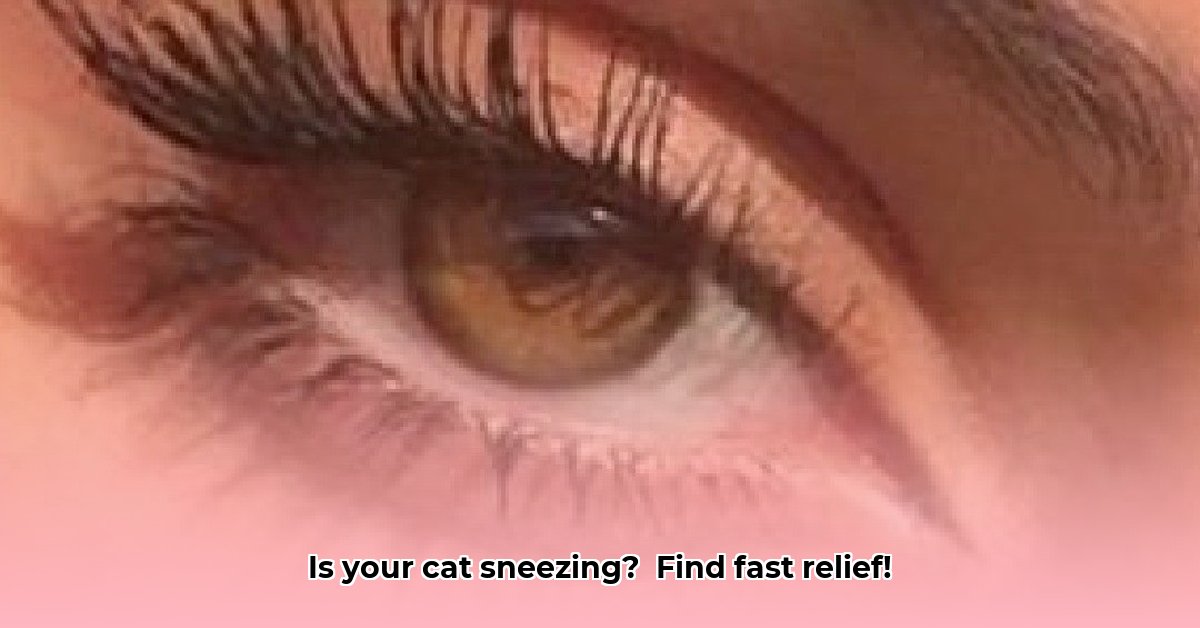Seeing your cat sneeze and have watery eyes can be worrying. This guide will help you understand the potential causes, ranging from simple allergies to more serious illnesses, and how to help your feline friend feel better quickly. While less common in cats than in dogs, it’s important to be aware of feline parvo.
Understanding Feline Sneezing and Watery Eyes: Causes and Concerns
Is your furry friend sneezing and battling watery eyes? It’s a common kitty complaint, often linked to a simple upper respiratory infection (URI). Think of it like a human cold – sometimes it’s a minor nuisance, sometimes it’s something more. Let’s explore the possibilities and get your cat feeling better, considering potential complications arising from infections like Bordetella bronchiseptica.
Interpreting Your Cat’s Symptoms: What is Normal?
While occasional sneezes might be nothing to worry about, persistent or worsening symptoms need a vet’s attention. Pay attention to the details; it makes all the difference in ensuring your pet’s health. It is important to note any change in behavior, appetite, or energy level.
What to watch out for:
- Sneezing frequency and force: Infrequent sneezing, perhaps once or twice a day, is generally benign. Frequent, forceful sneezes, occurring multiple times an hour, usually warrant a closer look and potential veterinary evaluation.
- Eye discharge: Clear, watery discharge is often less cause for concern than thicker, colored mucus. Yellowish or greenish discharge suggests a potential bacterial infection and requires prompt attention. Red-tinged discharge can indicate injury or more severe inflammation.
- Nasal discharge: Note the color and consistency of any nasal discharge. Clear discharge might indicate allergies or a mild viral infection, while colored discharge typically points to a bacterial infection.
- Other signs of illness: Is your cat unusually sleepy (lethargic)? Has their appetite decreased or disappeared entirely? Is there a nasal discharge or fever? These are red flags indicating a potentially serious problem due to a pathogen like feline herpesvirus (FHV). A rectal temperature above 102.5°F (39.2°C) in cats is generally considered a fever.
- Breathing difficulties: Rapid breathing, labored breathing, or open-mouth breathing are emergencies and require immediate veterinary care.
- Changes in behavior: Hiding, decreased interaction, or aggression can all indicate that your cat is not feeling well.
- Loss of appetite: A decreased or complete loss of appetite for more than 24 hours is concerning and warrants a vet visit. Dehydration can quickly become a problem.
Common Causes of Sneezing and Watery Eyes in Cats: Ruling out Allergens
Several factors could be making your cat sneeze and have watery eyes:
- Viral Infections: Feline herpesvirus (FHV) and feline calicivirus (FCV) are highly contagious and can cause significant discomfort. Vaccination against these is vital, although it doesn’t always prevent infection entirely. It can, however, minimize the severity of the symptoms.
- Bacterial Infections: Bacteria like Chlamydia felis, Bordetella bronchiseptica, and Mycoplasma spp. can lead to infections requiring antibiotics to resolve. Bacterial infections can sometimes occur secondary to a viral infection.
- Fungal Infections: Although less common, fungal infections, such as aspergillosis or cryptococcosis, can affect the nasal passages and sinuses, leading to sneezing and discharge.
- Allergies: Pollen, dust mites, mold spores, and certain food ingredients, acting as irritants, can lead to sneezing and watery eyes. Cats can develop allergies at any age.
- Irritants: Dust, smoke, strong fumes (like cleaning products or perfumes), certain household cleaning products, and even some types of cat litter can cause irritation to the nasal passages and eyes.
- Foreign Bodies: Grass seeds, small pieces of debris, or other foreign materials can become lodged in the nasal passages, causing irritation and sneezing.
- Dental Disease: Infections arising from severe dental disease can sometimes spread to the sinuses, leading to nasal discharge and sneezing.
- Nasal Polyps or Tumors: While less common, nasal polyps or tumors can cause chronic sneezing and nasal discharge.
- Vaccination Reactions: In rare cases, a cat might experience mild sneezing or watery eyes following a vaccination. These symptoms are usually short-lived.
LSI Keywords: Diagnosing Feline URI with Advanced Diagnostic Tests
Your vet will give your cat a thorough physical examination. They might recommend some tests to pinpoint the exact cause. In such situations, diagnostic testing would be highly beneficial in effectively treating sneezing and watery eyes.
- PCR testing: This test can identify specific viral culprits like FHV and FCV with high accuracy from nasal or conjunctival swabs. It can also detect some bacterial and fungal pathogens.
- Culture and sensitivity testing: This helps detect bacterial infections and determine which antibiotics would be most effective. A culture involves growing the bacteria in a lab, while sensitivity testing determines which antibiotics will kill or inhibit the bacteria’s growth.
- Blood tests: A complete blood count (CBC) and biochemistry profile can help assess your cat’s overall health and identify any underlying conditions, such as immune system problems or organ dysfunction.
- Rhinoscopy: In cases of chronic sneezing or nasal discharge, a rhinoscopy (examination of the nasal passages with a small camera) may be necessary to visualize the nasal passages and obtain samples for biopsy or culture.
- Radiographs (X-rays) or CT scans: These imaging techniques can help identify any structural abnormalities, such as nasal tumors or foreign bodies.
- Allergy testing: If allergies are suspected, your vet may recommend allergy testing (either skin testing or blood testing) to identify specific allergens.
Treatment Options for Feline Illnesses: Relief for Your Cat
Treatment depends entirely on what’s causing the issue:
- Viral infections (like FHV and FCV): Treatment focuses on supportive care – providing fluids (either orally or intravenously), keeping your cat comfortable, and managing any secondary infections. Nutritional support may be needed if your cat is not eating. Humidification can also help to loosen nasal secretions. L-lysine, an amino acid, is sometimes used as a supplement to help manage FHV infections, although its effectiveness is debated. Antiviral medications, such as famciclovir, might be used in severe cases.
- Bacterial infections: If bacteria are the problem, your vet will likely prescribe antibiotics to clear up the infection. The choice of antibiotic will depend on the type of bacteria identified on culture and sensitivity testing.
- Fungal Infections: Antifungal medications, such as itraconazole or fluconazole, are used to treat fungal infections. Treatment can be lengthy, sometimes lasting for several weeks or months.
- Allergies: If allergies are suspected, your vet might recommend allergy testing. Treatment then focuses on managing the environment to minimize exposure to allergens. This might involve using air purifiers, switching to hypoallergenic cat litter, or feeding a special diet. Antihistamines or corticosteroids might also be considered to help relieve symptoms.
- Foreign Bodies: Foreign bodies need to be removed, usually under sedation or anesthesia.
- Dental Disease: Addressing dental disease involves professional dental cleaning and, in some cases, extraction of infected teeth.
- Nasal Polyps or Tumors: Treatment for nasal polyps or tumors may involve surgery, radiation therapy, or chemotherapy, depending on the specific situation.
Long-Term Feline Health: Prevention and Ongoing Care
Most cats recover fully from URIs with proper treatment and care. However, certain conditions like FHV can recur, especially during times of stress. Follow your vet’s advice and continue monitoring your cat’s health even after the initial symptoms have subsided. Regular veterinary checkups and vaccinations are essential for maintaining your cat’s health. Keep your cat indoors to minimize exposure to infectious agents and allergens. Provide a clean and stress-free environment to support your cat’s immune system.
Consider these points about different pathogens:
| Pathogen | Severity (1-5) | Contagiousness (1-5) | Treatment | Possible Long-Term Effects | Prevention |
|---|---|---|---|---|---|
| Feline Herpesvirus (FHV) | 3-4 | 5 | Supportive care, sometimes antivirals | Recurring infections, eye problems | Vaccination, stress reduction |
| Feline Calicivirus (FCV) | 2-3 | 4 | Supportive care, sometimes antivirals | Recurring infections, mouth sores | Vaccination, good hygiene |
| Chlamydia felis | 2-3 | 3 | Antibiotics | Eye inflammation | Good hygiene, isolation of infected cats |
| Bordetella bronchiseptica | 1-4 | 3 | Antibiotics | Pneumonia (in severe cases) | Vaccination (especially for cats in multi-cat environments), good ventilation |
| Mycoplasma spp. | 2-3 | 3 | Antibiotics | Chronic respiratory issues | Good hygiene, avoiding overcrowding |
| Fungal Infections | 3-5 | 1-3 |
- Gluten Free Meal Prep Ideas for Delicious, Hassle-Free Eating - November 28, 2025
- Gluten Free Meal Prep for Stress-Free and Healthy Eating - November 27, 2025
- Quick And Easy Chicken Thigh Meal Prep For Weight Loss - November 26, 2025










